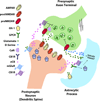Roles of Presynaptic NMDA Receptors in Neurotransmission and Plasticity
- PMID: 26726120
- PMCID: PMC4716805
- DOI: 10.1016/j.tins.2015.11.001
Roles of Presynaptic NMDA Receptors in Neurotransmission and Plasticity
Abstract
Presynaptic NMDA receptors (preNMDARs) play pivotal roles in excitatory neurotransmission and synaptic plasticity. They facilitate presynaptic neurotransmitter release and modulate mechanisms controlling synaptic maturation and plasticity during formative periods of brain development. There is an increasing understanding of the roles of preNMDARs in experience-dependent synaptic and circuit-specific computation. In this review we summarize the latest understanding of compartment-specific expression and function of preNMDARs, and how they contribute to synapse-specific and circuit-level information processing.
Keywords: NMDA receptors; cortex; development; synaptic plasticity.
Copyright © 2015 Elsevier Ltd. All rights reserved.
Figures



References
-
- Paoletti P, et al. NMDA receptor subunit diversity: impact on receptor properties, synaptic plasticity and disease. Nat Rev Neurosci. 2013;14:383–400. - PubMed
Publication types
MeSH terms
Substances
Grants and funding
- BB/H002383/BB_/Biotechnology and Biological Sciences Research Council/United Kingdom
- G0001354/MRC_/Medical Research Council/United Kingdom
- R01 NS085093/NS/NINDS NIH HHS/United States
- BB/H002383/2/BB_/Biotechnology and Biological Sciences Research Council/United Kingdom
- G1000183/MRC_/Medical Research Council/United Kingdom
LinkOut - more resources
Full Text Sources
Other Literature Sources

